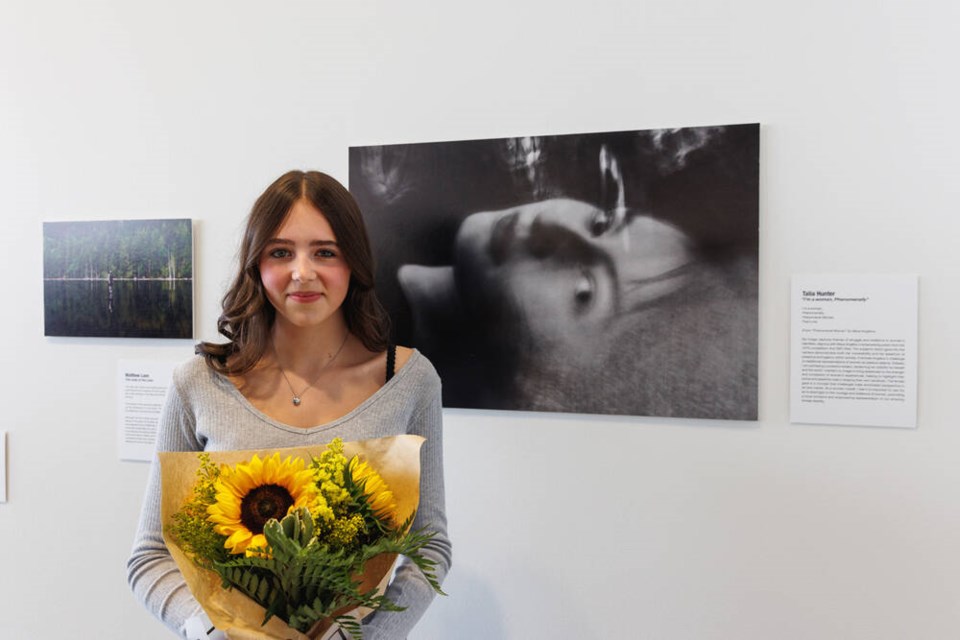What makes a good photograph?
Art is subjective, but according to Jana Ghimire, the curator of The Polygon’s Chester Fields photography competition, there are a few certain elements that make some photographs a cut above the rest.
Creativity and inventiveness are key. Has the photographer paid close attention to composition? To light? Do those selections align with the subject matter that they have chosen to showcase? And, in the case of Chester Fields, how does the photo align with the theme?
For this year’s edition of the annual teen photography showcase, a number of students from the ten schools that participated managed to tick all of the above boxes. Two of whom – Talia Hunter and Caleb Wang – were from West Vancouver’s Sentinel Secondary school.
“These are the ones we thought responded to the theme in a really creative way,” said Ghimire. The theme, 'mythmakers', was inspired by the shapeshifting elements to US artist Martine Gutierrez’s Anti-Icon: Apokalypsis exhibition, now showing at The Polygon.
“We felt that the students had a really sophisticated understanding of it,” she said, adding how the “really lovely, sincere statements” written by the artists to accompany their piece resonated particularly deeply with the judges.
Hunter, whose image depicts a female subject staring into the lens, said the theme of 'mythmakers' had inspired her to take the famous words of Maya Angelou’s Phenomenal Woman and reinterpret them visually.
“I wanted the girl’s gaze in the photo to represent both power, yet vulnerability, and to reinterpret traditional depictions of women in history, transforming them into active and powerful individuals,” she said. “I believe the judges were drawn to the way my photo connects the past with the present, and how it shows and represents how much women have evolved within society.”
With many students not learning about the female gaze until university, Ghimire said the depth of Hunter’s knowledge was a persuading facet for the judges narrowing down the winners.
Caleb Wang’s winning piece, a shot of a shadowed arm holding a human liver, interwove the theme of 'mythmakers' with ancient Greek mythology. Wang was inspired by the myth of Prometheus, in particular the story of Zeus’ punishment of the trickster Titan.
“To depict the myth as an image, I decided to portray myself as if I was offering my own liver to the Olympian gods,” said Wang in his explanatory statement. “I sought out specific lighting to emphasize this and also to suggest that I offer my liver in hopes of a brighter future for humanity. Lastly, I decided to colour myself in grayscale to convey that, by giving up my liver, a Greek symbol of one’s passion, I have faded into an empty husk.”
The finished product was an “ambitious photo” that incited thought and conversation from the panel of judges, said Ghimire.
“Caleb made a lot of very strong choices, and he stuck to them. To have this very, very high contrast image where it is strongly lit, and all the attention is on this dramatic grasping of the liver, it stood out immediately,” she said. “It is not an overly complicated image, but it’s certainly one that’s quite poetic.”
Both students had been surprised to learn of their win, said Ghimire, as so many winners have been since the competition first began in 2009. Claiming the top spot in the competition brings home more than just a beautiful bouquet of flowers. The winners, more often than not, gain a new found confidence in their own artistic abilities, Ghimire said.
For those that are apprehensive to have their work placed in the competition, Ghimire has a spot of simple advice:
“Throw your hat in the ring. It can’t hurt."
Mina Kerr-Lazenby is the North Shore News’ Indigenous and civic affairs reporter. This reporting beat is made possible by the Local Journalism Initiative.



